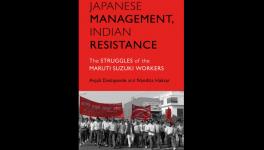July 18 Manesar Violence: 11 Years of Struggle by Maruti Workers Takes a Toll on Their Lives

Industrial workers march in Gurugram on Monday, demanding withdrawal of false cases in the 2012 Maruti violence case. Image clicked by Ronak Chhabra
New Delhi: Recalling the violence in Maruti’s Manesar plant on July 18, 2012, the Maruti Suzuki Workers’ Union held a demonstration in front of Mini Secretariat in Gurgaon, demanding that all suspended workers be reinstated. The demonstration saw an overwhelming presence of workers who were or were suspended/ terminated after the incident, with some of them being slapped with ‘false’ cases. The protest also saw a huge presence of workers from other factories such as Hitachi and Bellsonica who had joined in to express solidarity with the Maruti workers.
After the demonstration, the workers took out a march around the industrial belt in Haryana. The union also submitted a memorandum to the authorities with five demands that included the suspension of life imprisonment of all the workers, taking back false cases and suspension of all the labour codes.
On July 18, 2012, violence took place inside the Maruti Manesar plant, leading to the death of a human resource manager. This was followed by a lock-out, after which the management, aided by the police, began a “witch hunt” of workers, said union sources. This led to the suspension of 546 permanent and 1,800 contractual workers. According to Maruti Suzuki Mazdoor Sangh, 426 workers were not even listed in the final list of the Special Investigation Team (SIT) of the Haryana government, yet they had to lose their jobs. Hundreds of workers including the union leaders were arrested and put in jail. In March, 2017 13 out of the 148 accused workers were given life sentence.
One of the jailed workers, who is currently on bail, after spending 10 years in jail, told Newsclick on the condition of anonymity that: “Not only us, our families have also suffered because of the charges slapped against us that sent us to jail. I was the sole earner of the family. The false charges against me and the other members of the unions had broken our families back in our villages, not only financially but socially too. It took a long time for our families to support us.”
The worker said they stood firm on the stand that the charges of murder and riots against the workers were false and the State and Maruti had done so to discredit the entire workers’ movement that was fighting for dignified working conditions.
Another worker out on bail, who also refused to be named, referred to that period of his life as a “learning lesson”. He said the time spent in jail had only increased their faith in the cause that they fought for.
“Speaking for labour rights took away 10 precious years of my life. We were fighting against the inhuman working conditions. A practice that was being normalised by the Maruti management. We are proud of the fact that we fought for our brothers. In the last 10 years, a lot has been taken away from us but this journey taught us a lot too,” he added.
What exactly happened on July 18, 2012?
The day was the culmination of the struggle that was taking place in Maruti Suzuki for several years between workers and the Maruti management. The trigger for the event was an argument between a foreman and a worker ‘Jiya Lal’. According to workers, a casteist slur was used by a foreman for Jiya, which became the trigger for an argument. This led to the termination of the worker ‘Jiya Lal’, however, the workers’ union had demanded the suspension of both the persons (foreman) involved.
Read Also: Maruti Suzuki Workers Get to Tell Their Story at Last
To fulfil this demand, the workers started protesting in the factory. The event took a dramatic turn when violence erupted in the factory premises amid the protest and a human resource manager, Awanish Kumar Dev, was killed in the violence that took place that day. The violence also left approximately 50 workers injured.
The management blamed the protesting workers for the death of the manager, however, the workers and union alleged the management and police’s role in instigating the violence through outside force. According to the workers, the people who started violence were ‘bouncers’ hired by the management to discredit the workers’ movement.
Labour researcher Rakhi Sehgal had published a detailed report on the happenings of that day which suggest that the incident was the culmination of the anger and frustration that workers were feeling for months as the management had refused to recognise the elected union. The union had become incapable of exercising their rights for equal pay and dignified working conditions.
‘Fight for Survival, State Apathy, Corporate-State Nexus’
On Tuesday, several workers gathered in the Gurugram protest were those who are fighting cases in courts to get justice. The fight has taken a lot from them in the past 11 years, they said.
The long pending cases have also drained the workers financially and personally. Speaking with Newsclick, Surender Malik (42), a worker, said the prolonged struggle was taking a toll on the lives of the young workers.
“This struggle costs us a lot in terms of finances and our personal lives. We are not able to send our children to good schools. All of us are technical degree holders but we are working on fields such as dairy and farming. The income is not sufficient there but we do not have any other form of employment”, he added.
Another suspended worker Devender Jankhad (45) told Newsclick about the image and clout that auto major Maruti used had due to which their struggle had become a lot harder.
“The kind of working conditions then were not human but we were not able to share it with anybody else. People wouldn’t, even our own families, wouldn't believe us as Maruti was seen as the worker-friendly company,” he added.
Khushi Ram (37) highlighted the apathy that the suspended workers had to face in the past 11 years. According to him, not only the Maruti management but the State and judiciary had also “failed the workers” in the past 11years.
Read Also: Maruti 2012 Violence Case: ‘Injustice’ to Terminated Workers Decried
“We are poor people. We do not have enough resources to present the best arguments in favour of our case. The corporations can hire the most expensive lawyers but how can we get something of that stature with the kind of finances we have?”, said a worker.
Talking about the future of the struggle, the union said it would keep fighting for workers’ rights.
What changed in Maruti for workers after the 2012 incident
In 2012, the working conditions in the Maruti Manesar factory became one of the most disputed issues between the workers’ union and the management. The issues ranged from not getting leave, to exhaustion due to excessive workload, along with the issues of equal pay for contractual and permanent workforce.
Requesting anonymity, a permanent worker currently working with Maruti, shed light on the current labour practices in the company. According to him, the issues of permanent workers are not as severe as they were before 2012, as the working conditions have improved, but the issues of contractual workers have remained the same.
“The company has drastically reduced the permanent workforce and only engages in employing contractual workers as it becomes easy for the management to lay off. Maruti has just started its own ITI course through which it is employing the young workforce (apprentices) into the plants. It gets the work done through these young apprentices and then replaces them with a new workforce. This practice is currently stirring up anger amongst the current workforce,” he claimed.
According to him, the participation of a large number of current Maruti workforce in Tuesday’s demonstration confirmed the fact that workers still feel that working conditions of the company oppressive.
Get the latest reports & analysis with people's perspective on Protests, movements & deep analytical videos, discussions of the current affairs in your Telegram app. Subscribe to NewsClick's Telegram channel & get Real-Time updates on stories, as they get published on our website.
























